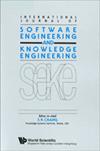GTFP: Network Fault Prediction Based on Graph and Time Series
IF 0.6
4区 计算机科学
Q4 COMPUTER SCIENCE, ARTIFICIAL INTELLIGENCE
International Journal of Software Engineering and Knowledge Engineering
Pub Date : 2023-10-18
DOI:10.1142/s0218194023500560
引用次数: 0
Abstract
With the explosion of 5G network scale, the network structure becomes increasingly complex. During the operation of the network devices, the probability of anomalies or faults increases accordingly. Network faults may lead to the disappearance of important information and cause unpredictable losses. The prediction of network faults can enhance the quality of network services and reduce economic loss. In this paper, we propose the concept of 4D features and use the BERT algorithm to extract semantic features, the graph neural network algorithm to extract network topology information, and the Temporal Convolutional Network (TCN) algorithm to extract time series. Based on this, we propose Fault Prediction based on GraphSage and TCN (GTFP), an end-to-end solution of network fault alarm prediction, which is based on GraphSage and TCN (GTCN), a hybrid algorithm of a graph neural network and the TCN model. Our solution takes the historical alarm data as input. First, we filter out the alarm noises irrelevant to the faults through data cleaning. Then, we employ feature engineering to extract the valid alarm features, including the statistical features of the network alarm information, the semantic features of the alarm texts, the sequential features of the alarms and the network topology features of the nodes where the alarms are located. Finally, we use GTCN to predict future fault alarms based on the extracted features. Experiments on the alarm data of a real service system show that GTFP performs better than the state-of-the-art algorithms of fault alarm prediction.基于图和时间序列的网络故障预测
随着5G网络规模的爆炸式增长,网络结构日趋复杂。在网络设备的运行过程中,出现异常或故障的概率也会随之增加。网络故障可能导致重要信息丢失,造成不可预测的损失。网络故障预测可以提高网络服务质量,减少经济损失。本文提出了四维特征的概念,并采用BERT算法提取语义特征,图神经网络算法提取网络拓扑信息,时间卷积网络(TCN)算法提取时间序列。在此基础上,提出了基于GraphSage和TCN的故障预测(GTFP),这是一种基于GraphSage和TCN (GTCN)的网络故障告警预测的端到端解决方案,是一种图神经网络和TCN模型的混合算法。我们的解决方案以历史告警数据为输入。首先,通过数据清洗过滤掉与故障无关的报警噪声。然后,利用特征工程提取有效的告警特征,包括网络告警信息的统计特征、告警文本的语义特征、告警的序列特征以及告警所在节点的网络拓扑特征。最后,基于提取的特征,利用GTCN对未来的故障告警进行预测。在实际业务系统报警数据上的实验表明,GTFP算法比现有的故障报警预测算法具有更好的预测效果。
本文章由计算机程序翻译,如有差异,请以英文原文为准。
求助全文
约1分钟内获得全文
求助全文
来源期刊
CiteScore
1.90
自引率
11.10%
发文量
71
审稿时长
16 months
期刊介绍:
The International Journal of Software Engineering and Knowledge Engineering is intended to serve as a forum for researchers, practitioners, and developers to exchange ideas and results for the advancement of software engineering and knowledge engineering. Three types of papers will be published:
Research papers reporting original research results
Technology trend surveys reviewing an area of research in software engineering and knowledge engineering
Survey articles surveying a broad area in software engineering and knowledge engineering
In addition, tool reviews (no more than three manuscript pages) and book reviews (no more than two manuscript pages) are also welcome.
A central theme of this journal is the interplay between software engineering and knowledge engineering: how knowledge engineering methods can be applied to software engineering, and vice versa. The journal publishes papers in the areas of software engineering methods and practices, object-oriented systems, rapid prototyping, software reuse, cleanroom software engineering, stepwise refinement/enhancement, formal methods of specification, ambiguity in software development, impact of CASE on software development life cycle, knowledge engineering methods and practices, logic programming, expert systems, knowledge-based systems, distributed knowledge-based systems, deductive database systems, knowledge representations, knowledge-based systems in language translation & processing, software and knowledge-ware maintenance, reverse engineering in software design, and applications in various domains of interest.

 求助内容:
求助内容: 应助结果提醒方式:
应助结果提醒方式:


